The Atchafalaya River in Louisiana is epically beautiful. The nearby Atchafalaya River Basin is a nature-loving kayaker’s dream but watch out for the gators! The river is the fifth largest in North America, at a staggering 137 miles long! It connects to the Mississippi and Red Rivers in south-central Louisiana.
The Atchafalaya Basin was formed thousands of years ago as part of the construction maintenance of the Mississippi. Most of the land contained in the basin was developed by the Cypremort/Sale and the Teche lobes of previous Mississippi River delta complexes. Geologists would not classify the Atchafalaya River as a river since it has been a distributary of the Mississippi River since the 1500s.
The Atchafalaya River can reach levels above 12 feet during the flood stage after heavy rains. The U.S. Corps of Engineers states that the Atchafalaya River at the port is maintained at 12 feet deep and 1000 feet wide. The port is adjacent to State Highway 105 and one mile south of U.S. Highway 190 in Louisiana.
What’s in the Atchafalaya River?
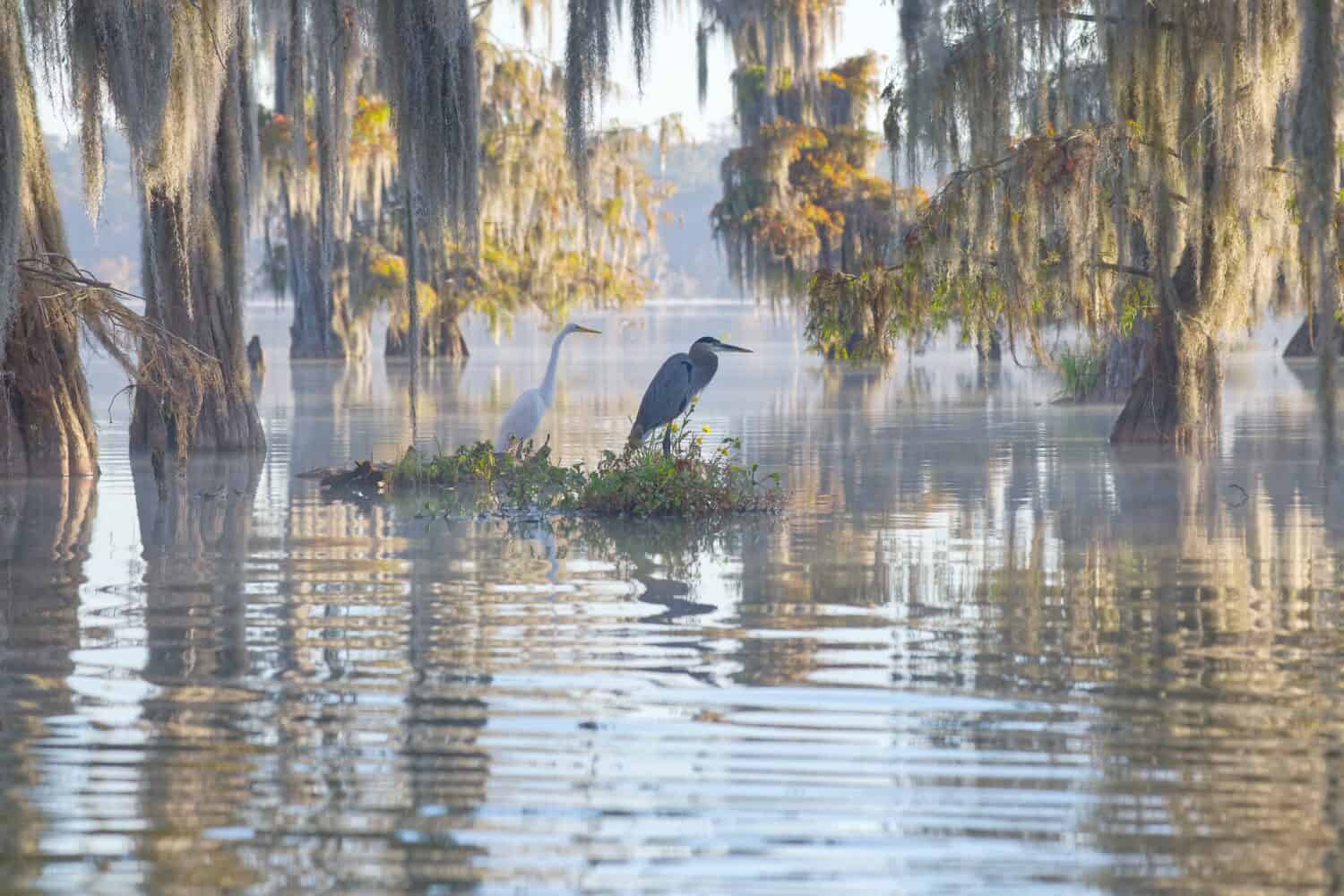
©Xiu Yu Photography/Shutterstock.com
The Atchafalaya River and the Atchafalaya River Basin are home to many plant and animal species ranging from nutria rats to bull sharks. The river connects to the Gulf, and many of the ocean life that can tolerate brackish water have found a home in the Atchafalaya Basin and River.
The Atchafalaya Swamp is home to many turtles, alligators, garfish, frogs, lizards, and of course, nutria. Hundreds of fish species call the Atchafalaya home, along with thousands of plant and animal life species. The amount of insect species in the swamps and around the river is off the charts. Since this is a sweltering and humid area, mosquitos are highly abundant, making for a serious need to wear insect repellant any time you are in the area boating or walking on swampy trails. The most significant rule of the Atchafalaya Swamp, River, and Basin is to enjoy nature but leave it alone. It will be quick to remind you if you mess up.
American Alligator (Alligator mississippiensis)
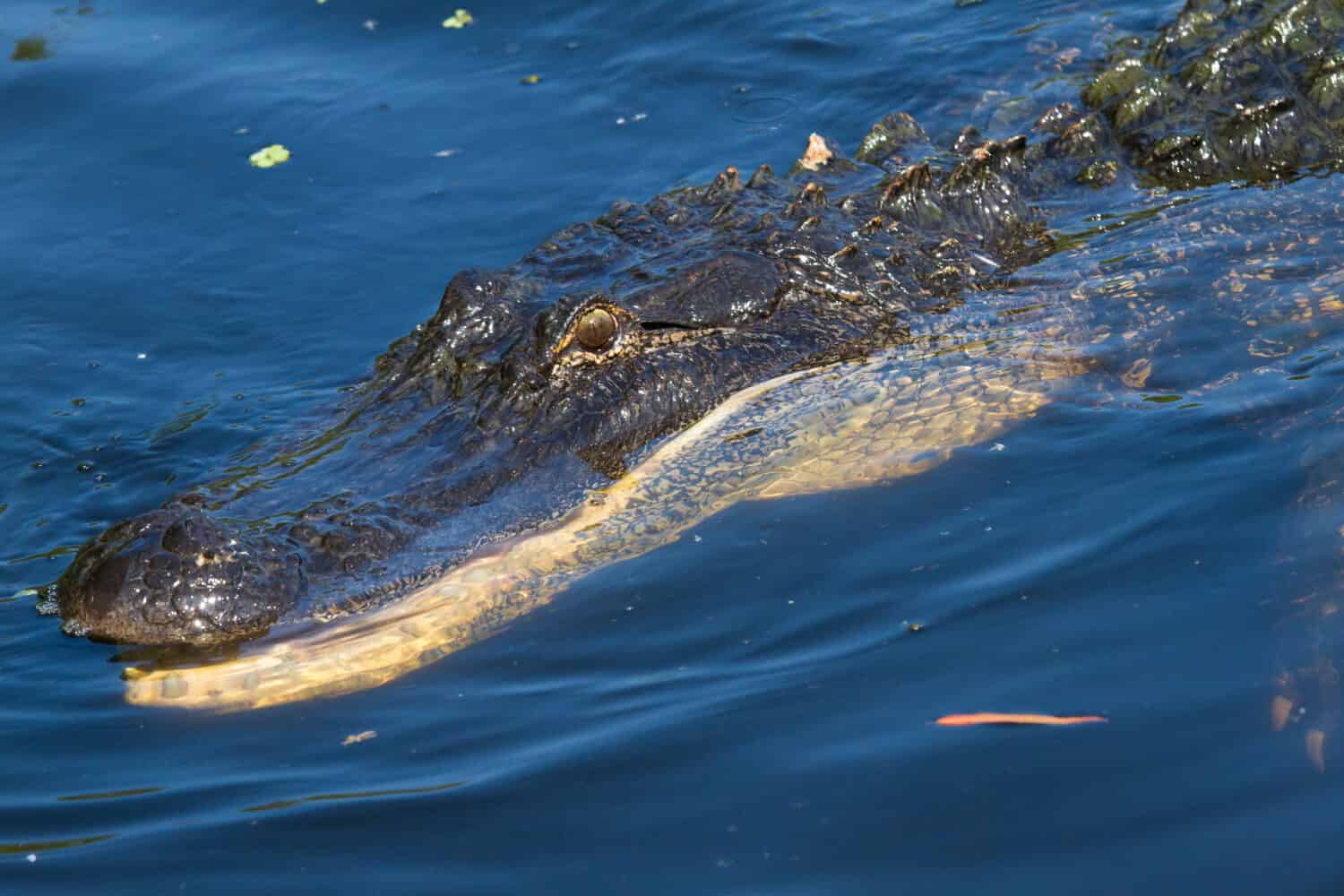
Alligators are impossible not to see in the Atchafalaya Basin and swamp since they prefer low-maintenance lifestyles with very little exercise. They can also be found in the river, but the currents can be strong, and these lazy lizards prefer to lounge.
©Sasha Craig/Shutterstock.com
American alligators are gigantic, prehistoric lizards that enjoy the easy life in the swamps. They can weigh up to 500 pounds and grow to a length of 15 feet. They spend most of their time floating in the swamp, hanging out on the banks of the river, or cruising the basin. The prehistoric lizards primarily eat fish but will eat just about anything given the opportunity. These massive lizards are one huge reason not to swim in the Atchafalaya River, Basin, or Swamp.
Many people enjoy kayaking through the basin and swamp but be careful because these big guys are everywhere and are aggressive around mating season. The mama alligators are also highly protective of their cute little offspring, so avoid the banks and small islands where they nest. If you happen to see a cute little baby alligator all alone while you are kayaking, do NOT even consider being tempted to pick it up. For one, they bite, which can do some damage, but the main reason is that these little ones have a loud distress pip that will have their mama after you quickly.
Bull Shark (Carcharhinus leucas)
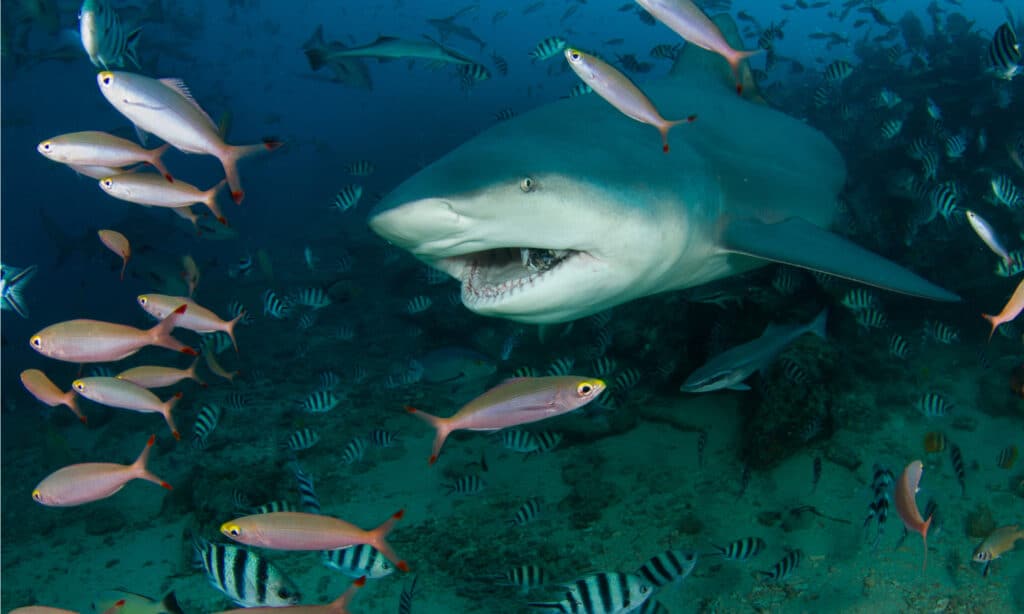
Bull sharks are able to swim in brackish water for their entire lives, unlike pure saltwater sharks. They have been found hundreds of miles upriver.
©chatchai kusolsinchai/Shutterstock.com
Bull sharks are not a shark you want to mess with since they are the most aggressive shark species. These sharks have been found 1000 miles up the Mississippi River and have no problem calling the Atchafalaya home. Anglers have been catching these sharks there for decades, and they are known to grow to 12 feet long. It is not uncommon to see a shark in those waters or Lake Pontchartrain in New Orleans, known for its shallow depth and water recreation.
Atlantic Stingray (Dasyatis sabina)
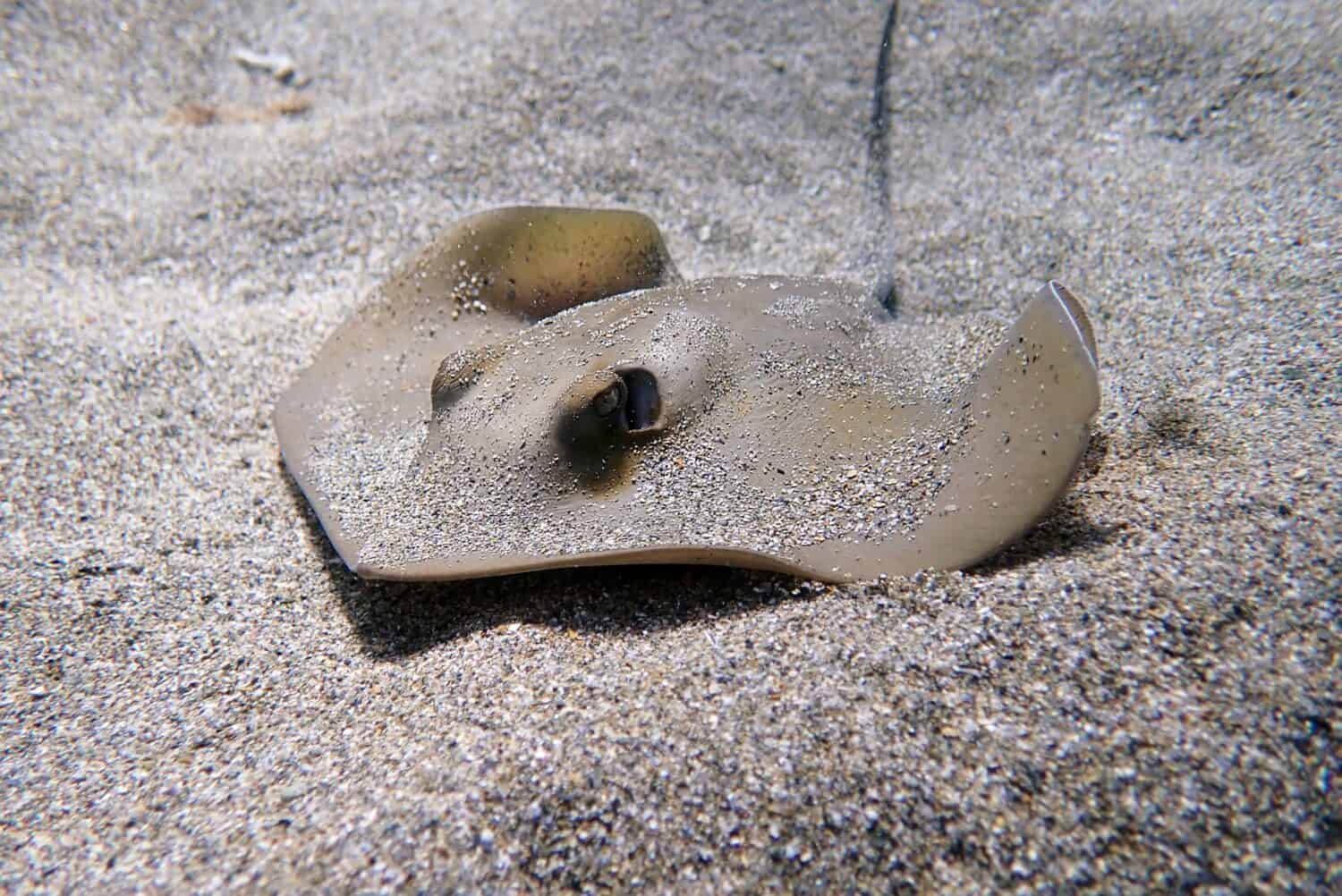
The Atlantic
stingray
hides at the bottom of the river basin.
©Vojce/Shutterstock.com
Atlantic stingrays have found their way into the swamps and decided its prime real estate. They are much smaller than the other river and swamp dwellers, the southern stingray, which can grow 6 feet from wing tip to wing tip. These animals are pretty harmless and really neat to see, but if you step on, threaten, or hurt one, you will be sorry. They have spikes on their tail filled with venom. They regrow the spike every year, so sometimes one can be seen with two spikes. You don’t want to get smacked with a two-stinger tail! The experts say that if you are stung, get to hot water quickly and soak the sting. Hot water breaks down the venom injected by their tails.
Speckled Worm Eel (Myrophis punctatus)

Speckled worm eel (
Myrophis punctatus) is not as dangerous as some eels, but they will fight like crazy if you try to catch or harm them.
©Smithsonian Environmental Research Center / CC BY 2.0 – License
The speckled worm eel isn’t much of a threat, though they can be a bit creepy and not something you want to step on. They can grow to one foot nine inches long and tend to live in the warm, brackish water of the Atchafalaya Swamp, River, and Basin. They dig into the muddy and sandy bottom of the river and call it their home. These strange-looking alien-like creatures can hurt you if you step on or try to hurt them. They will fight by biting, and it can hurt a bit.
Gafftopsail Catfish (Bagre marinus Mitchill)

Catfish are an important part of the river’s ecosystem.
©IrinaK/Shutterstock.com
There are many different types of catfish in the Atchafalaya. The Gafftopsail catfish comes equipped with venomous pectoral and dorsal fin spines. These fish are powerful fighters which makes catching them difficult. The record for the largest one caught is 27 inches long and 10 pounds. Most of the catfish are only around two pounds. Generally, the catfish spines cause a terrible stinging sensation, and a doctor must remove the spine if it breaks off in your skin. Though rare, sometimes the stung area can become necrotic, which causes much more severe symptoms. They are bottom feeders, like all catfish, and prefer to hide under aquatic tree roots, in holes, or under logs until night falls.
Shovelnose sturgeon (Scaphirhynchus platorynchus Rafinesque)
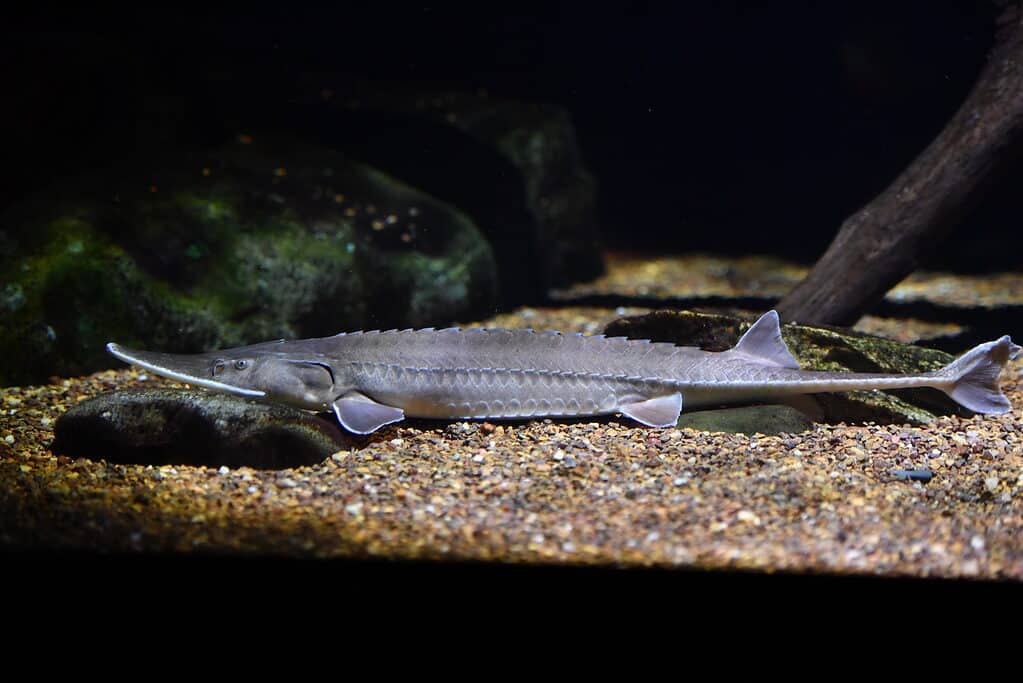
Sturgeons are ancient creatures, like the alligator.
©Andrea Izzotti/Shutterstock.com
Shovelnosed sturgeon can grow to be almost two feet long, which isn’t exactly nightmare-inducing considering our other Atchafalaya River creatures. These are the most abundant sturgeon in the Atchafalaya but mostly live at the bottom of the river and channel in the sandy sediment on the bottom. They can withstand brackish water for their lifetime. Sadly, overfishing occurs for their roe and their skin. Now they must be 8 – 10 years old to catch since they reach maturity then and only live to be approximately 13 years old. Other types of sturgeon can live up to 30 years old.
Alligator gar (Lepisosteus spatula Lacépède)
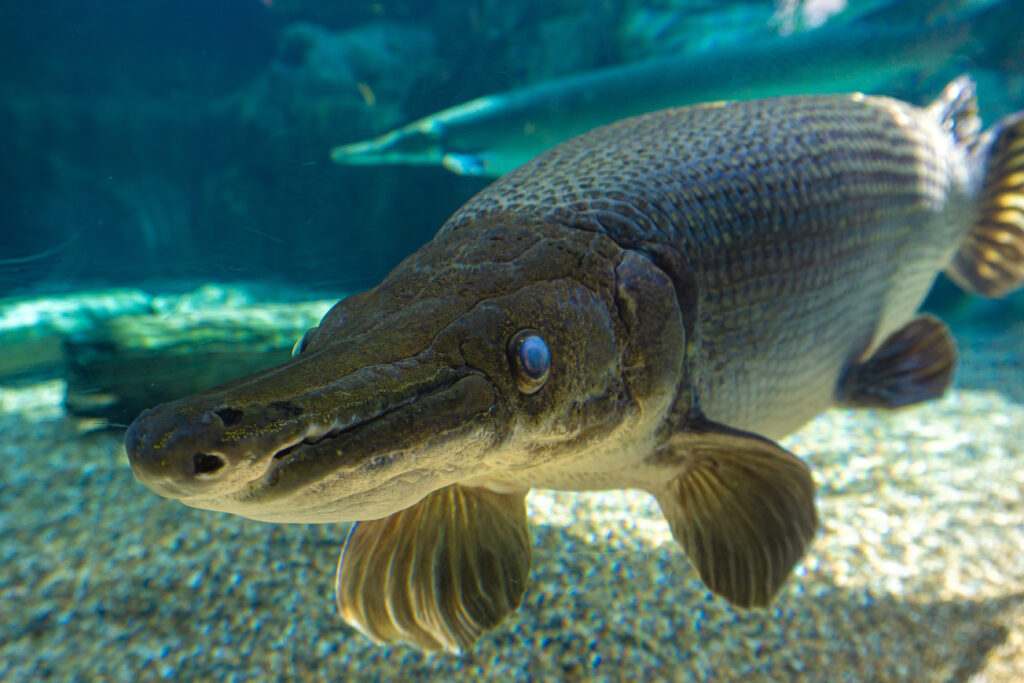
The alligator gar is a “living fossil” found largely in the southern United States.
©TKBackyard/Shutterstock.com
Alligator gar are unique creatures. They are docile and live a peaceful life cruising brackish water in swamps and bayous. They can grow enormous at 350 pounds and 10 feet long! The gar has a mouth filled with needle-sharp pointed teeth that they use to hunt fish. They can look like enormous snakes when they breach the water’s surface but are very timid, so they tend to stay below the surface, especially if they suspect humans around.
Alligator Snapping Turtle (Macrochelys temminckii)
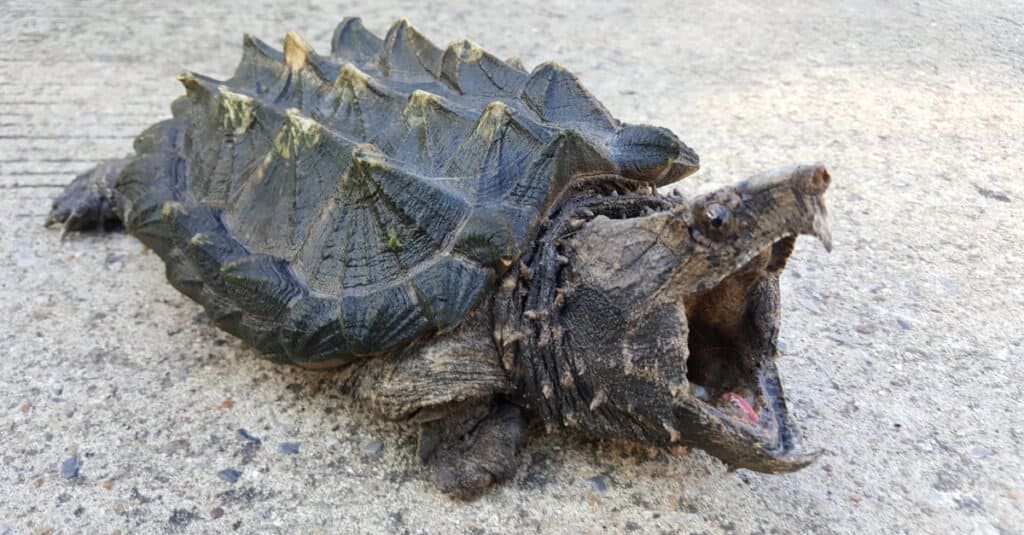
Alligator snapping turtle is another strange beast that Louisiana calls delicious.
©Sista Vongjintanaruks/Shutterstock.com
Another creature that makes the Atchafalaya a bit dangerous to swim in is the alligator snapping turtle. These big boys are not too friendly and don’t take kindly to being moved out of the road, let alone stepped on in a bayou. They strike first and don’t even bother to think about it again. Alligator snapping turtles can weigh as much as 115 pounds and be two feet wide! That is a massive turtle with a big mouth. Of course, Louisiana folks enjoy turtle soup made from snapping turtle meat.
Ships and Barges
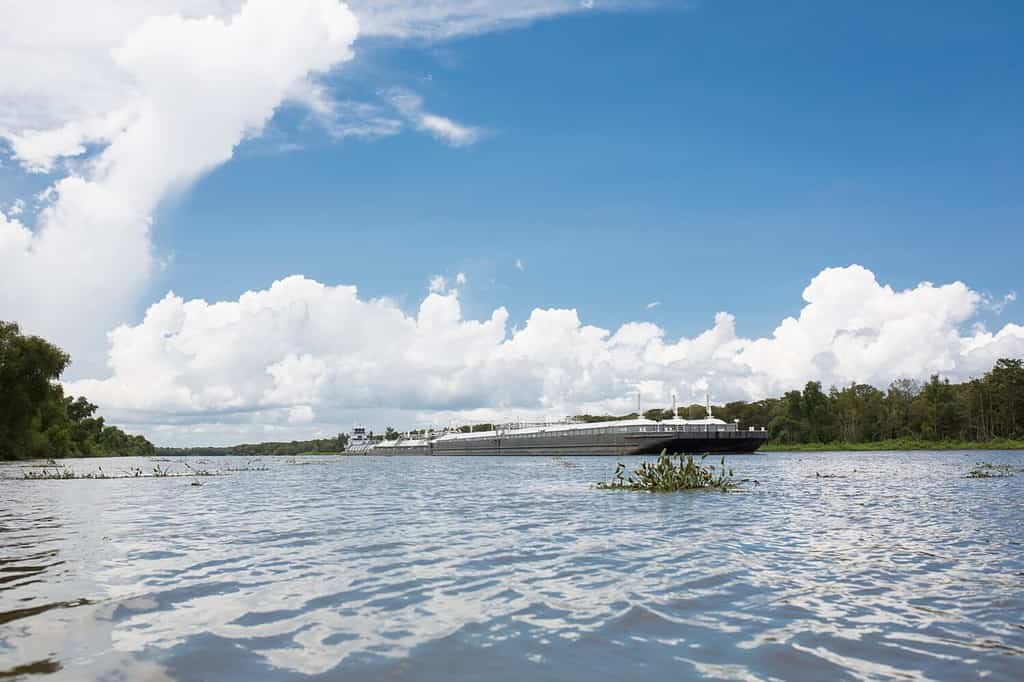
Ships and barges frequent the Atchafalaya River and are a cause of pollution in the water.
©Jennifer White Maxwell/Shutterstock.com
The Atchafalaya became a main distributary of the Mississippi from 1839 to 1849 when locals removed a massive 30-mile-long log raft jam (the Great Raft) that was obstructing the Atchafalaya River. Since then, the river has become a primary route of transport for ships and barges carrying a variety of cargoes for domestic and international markets, including asphalt, barite, aggregates, limestone, carbon black, coal, coffee, coke, grain, forest products, biomass products, plastics, liquid bulk chemicals, molasses, oats, ores, pipe, steel, and sugar.
Oil and Gas Pipeline Pollution

Abandoned pipelines are guilty of causing many tragedies involving wildlife, sealife, and river life. They will leak oil forever, and little can be done once the ball is in motion.
©FooTToo/Shutterstock.com
Large piles of soil left over from the oil and gas pipeline build disrupt the flow of the river and create sediment within the wetlands. Not only do the pipelines causes problems in the way of huge “levees” made of disposed of dirt, but the amount of leaking abandoned pipelines is a whole other animal that is much worse than a pile of dirt. These pipelines are the number one reason it is not safe to swim in any of the Atchafalaya bodies of water.
Oil Spills
Oil is a major carcinogen and causes many problems for our Louisiana coast. People will always fish in Louisiana, and many households depend on fishing in one way or another to support their household. The toxic coastal waters, swamps, bayous, and rivers have created a horrific scene regarding fishing. Some of Louisiana’s favorite meals, such as crawfish, shrimp, catfish, redfish, and oysters, come from the water. These are all toxic because of the amount of pollutants in the water inland and ocean. Sadly, oil is also a leading employment producer in Louisiana, and much more work in the oil field, whether offshore at drill sites and pipelines or at refineries between New Orleans and Baton Rouge.
After the BP oil spill, millions of wildlife were injured and killed. It was a horrible scene, and many people pitched in a hand to help save ocean wildlife, help clean up the shores, and offered to help skim the water to get as much oil out as possible. BP had guards along with the cost guard at most affected locations, and many people were imprisoned for helping because they were trespassing. It was a sorrowful time. Oil does not just “go away,” and suddenly, fishing is safe. It remains in the murky waterbeds, infiltrates the coastline permanently, kills fish and wildlife without rebound, and poisons the drinking water for everyone.
Mercury Levels

The mercury levels are high in the Atchafalaya River Basin and Swamp. Eating fish caught in these areas can be unhealthy, especially for pregnant women and children.
©iStock.com/ados
Mercury levels are very high in Big Alabama Bayou, connected to the Atchafalaya River. Testing has occurred throughout the Atchafalaya River, Basin, and Swamp, and all have come back contaminated. Mercury can cause many problems, from kidney and heart issues to hindering brain development and growth.
The warning is specifically for flathead catfish, another commonly found bayou, swamp, and lake catfish in Louisiana. The Louisiana Departments of Health, Environmental Quality, and Wildlife and Fisheries have advised that children under seven not eat more than two monthly meals containing these fish. Surely, other fish are also toxic in the Big Alabama Bayou and other areas fed by the Atchafalaya River. Even a little toxic is still very bad, and we’re only talking about mercury poisoning. Who knows what toxins are contaminating the fish of the Atchafalaya?
Is It Safe to Swim?
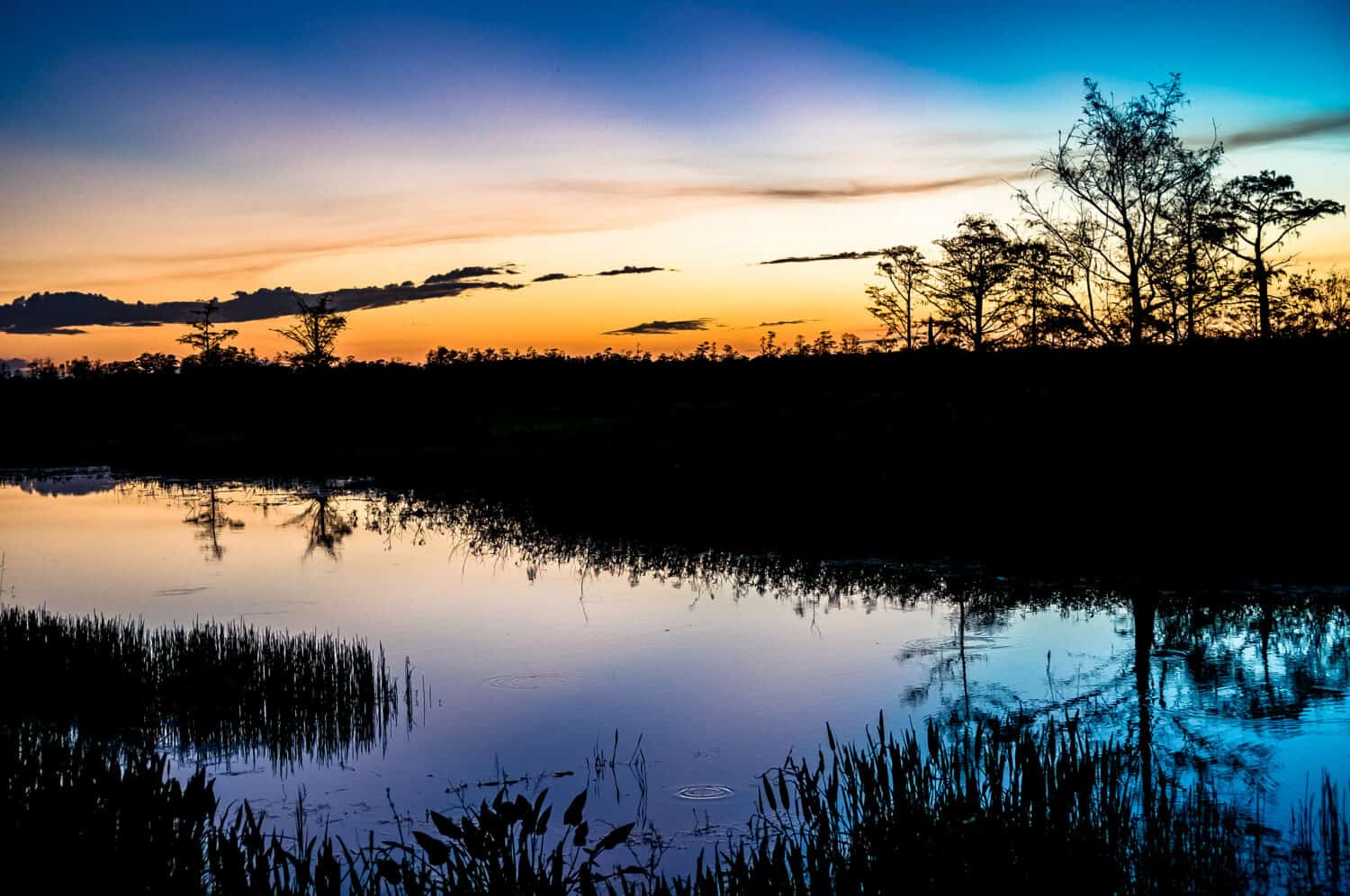
The old saying, “Swim at your own risk,” applies to the Atchafalaya River, Basin, and Swamps.
©jaimie tuchman/Shutterstock.com
Swimming in the Atchafalaya River is something that shouldn’t happen when there are far safer areas to swim in Louisiana. Between the bull sharks, alligators, oil and gas pipeline pollution, and mercury-poisoned fish, it’s wise to avoid swimming in this river.
It is a breathtakingly beautiful place with mangrove forests, cypress knots, and trees everywhere, all dressed with mystifying Spanish moss. The scenery is magical, too bad the parts you can’t see are terrible mistakes humans make. The murky water is anxiety-inducing on its own when you have your feet in the water but can’t see anything. The wildlife of bears, coyotes, birds of prey, sharks, alligators, and the infamous swamp monster is pretty scary. However, it doesn’t hold a candle to the scary things humans have caused, making this river and its waterways unswimmable.
FAQ
Q: What is the Atchafalaya known for?
A: The Atchafalaya is known for its surrounding cane sugar and cotton fields along with the 270+ different types of birds that inhabit it. Inhabiting the water are crawfish, oysters, shrimp, and catfish. You may even see one of the land-dwellers; black bears, coyotes, nutria, armadillos, raccoons, and a bunch of snakes.
Q: What are the threats to the Atchafalaya River Basin?
A: The Atchafalaya River basin is no stranger to a long list of threats. Illegal cypress logging, illegal development, pollution from oil and gas pipelines, increased sedimentation, and environmental laws not being upheld are just a few of the threats it faces daily.
Q: Why is the Atchafalaya Basin drying up?
A: Due to oil and gas pipelines disrupting the movement of water and sediment, natural levees have been made alongside the river, which tampers greatly with nature’s ability to move water and sediment into the wetlands.
The photo featured at the top of this post is © Sasha Craig/Shutterstock.com
Thank you for reading! Have some feedback for us? Contact the AZ Animals editorial team.







